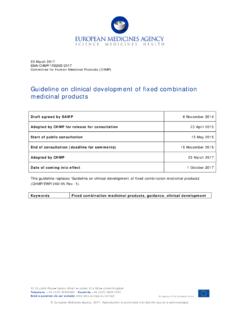Transcription of Excipients and information for the package leaflet EN v1
1 22 November 2019 EMA/CHMP/302620/2017 Rev. 1* Annex to the European Commission guideline on Excipients in the labelling and package leaflet of medicinal products for human use (SANTE-2017-11668) Excipients and information for the package leaflet Agreed by CHMP Excipients Drafting Group Adopted by EMA Committee for medicinal Products for Human Use (CHMP) Endorsed by European Commission's Notice to Applicants Group Date of publication 22 November 2019 This document replaces the Annex previously included in the Guideline CPMP/463/00 Rev.
2 1. It is an integral part of the European Commission guideline on Excipients in the labelling and package leaflet of medicinal products for human use (SANTE-2017-11668). Keywords Excipient, package leaflet , Labelling *Rev. 1 includes an update of July 201720 July 20174 October 2017 NameUpdated on Route of AdministrationThresholdInformation for the package LeafletCommentsAprotininTopicalZeroMay cause hypersensitivity or severe allergic topical route in this case refers to sites that may have access to the circulation ( wounds, body cavities etc.)
3 Arachis oil (peanut oil)AllZero< medicinal product> contains arachis oil (peanut oil). If you are allergic to peanut or soya, do not use this medicinal product. Purified arachis oil may contain peanut protein. The PhEur monograph does not contain a test for residual : (E 951)09/10/2017 OralZeroThis medicine contains x mg aspartame in each <dosage unit> <unit volume> <which is equivalent to x mg/<weight> <volume>>.Aspartame is a source of phenylalanine. It may be harmful if you have phenylketonuria (PKU), a rare genetic disorder in which phenylalanine builds up because the body cannot remove it is hydrolysed in the gastrointestinal tract when orally ingested.
4 One of the major hydrolysis products is to consider for the SmPC: Neither non-clinical nor clinical data are available to assess aspartame use in infants below 12 weeks of colouring :Tartrazine (E 102)Sunset yellow FCF (E 110)Azorubine, carmoisine (E122)Amaranth (E 123)Ponceau 4R, cochineal RedA (E 124)Brilliant black BN, black PN(E 151)OralZeroMay cause allergic of PeruTopicalZeroMay cause skin chloride09/10/2017 AllZeroThis medicine contains x mg benzalkonium chloride in each <dosage unit> <unit volume> <which is equivalent to x mg/<weight> <volume>>.
5 Excipients and information for the package leaflet Annex to the European Commission guideline on Excipients in the labelling and package leaflet of medicinal products for human use (SANTE-2017-11668)EMA/CHMP/302620/2017/E N Rev. 1 Page 1 of 19 NameUpdated on Route of AdministrationThresholdInformation for the package LeafletCommentsBenzalkonium chloride09/10/2017 Ocular ZeroBenzalkonium chloride may be absorbed by soft contact lenses and may change the colour of the contact lenses. You should remove contact lenses before using this medicine and put them back 15 minutes chloride may also cause eye irritation, especially if you have dry eyes or disorders of the cornea (the clear layer at the front of the eye).
6 If you feel abnormal eye sensation, stinging or pain in the eye after using this medicine, talk to your the limited data available, there is no difference in the adverse event profile in children compared to , however, eyes in children show a stronger reaction for a given stimulus than the adult eye. Irritation may have an effect on treatment adherence in chloride has been reported to cause eye irritation, symptoms of dry eyes and may affect the tear film and corneal surface. Should be used with caution in dry eye patients and in patients where the cornea may be compromised.
7 Patients should be monitored in case of prolonged chloride09/10/2017 NasalZeroBenzalkonium chloride may cause irritation or swelling inside the nose, especially if used for a long use may cause oedema of the nasal chloride09/10/2017 InhalationZeroBenzalkonium chloride may cause wheezing and breathing difficulties (bronchospasm), especially if you have asthma. Benzalkonium chloride09/10/2017 CutaneousZeroBenzalkonium chloride may irritate the should not apply this medicine to the breasts if you are breast feeding because the baby may take it in with your during pregnancy and lactation is not expected to be associated with harmful effects to the mother as cutaneous absorption of benzalkonium chloride is for application to chloride09/10/2017 Oromucosal, rectal and vaginalZeroBenzalkonium chloride may cause local acid (E 210) and.
8 Sodium benzoate (E 211)Potassium benzoate (E 212)09/10/2017 AllZeroThis medicine contains x mg <benzoic acid/benzoate salt> in each <dosage unit> <unit volume> <which is equivalent to x mg/<weight> <volume>>.Annex to the European Commission guideline on Excipients in the labelling and package leaflet of medicinal products for human use (SANTE-2017-11668)EMA/CHMP/302620/2017/E N Rev. 1 Page 2 of 19 NameUpdated on Route of AdministrationThresholdInformation for the package LeafletCommentsBenzoic acid (E 210) and :Sodium benzoate (E 211)Potassium benzoate (E 212)09/10/2017 Oral, parenteral Zero<Benzoic acid/Benzoate salt> may increase jaundice (yellowing of the skin and eyes) in newborn babies (up to 4 weeks old).
9 Increase in bilirubinaemia following its displacement from albumin may increase neonatal jaundice which may develop into kernicterus (non-conjugated bilirubin deposits in the brain tissue).Benzoic acid (E 210) and :Sodium benzoate (E 211)Potassium benzoate (E 212)09/10/2017 TopicalZero<Benzoic acid/Benzoate salt> may cause local cause non-immunologic immediate contact reactions by a possible cholinergic acid (E 210) and :Sodium benzoate (E 211)Potassium benzoate (E 212)09/10/2017 TopicalZero<Benzoic acid/Benzoate salt> may increase jaundice (yellowing of the skin and eyes) in newborn babies (up to 4 weeks old).
10 Absorption through the immature skin of neonates is alcohol09/10/2017 AllZeroThis medicine contains x mg benzyl alcohol in each <dosage unit> <unit volume> <which is equivalent to x mg/<weight> <volume>>.Benzyl alcohol may cause allergic alcohol09/10/2017 Oral, parenteral ZeroBenzyl alcohol has been linked with the risk of severe side effects including breathing problems (called gasping syndrome ) in young not give to your newborn baby (up to 4 weeks old), unless recommended by your administration of benzyl alcohol has been associated with serious adverse events and death in neonates ( gasping syndrome ).










